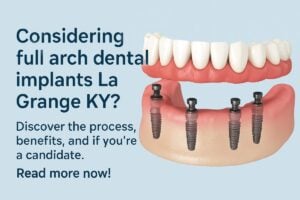Dental implant post care is the set of steps you follow after implant surgery to help your mouth heal and the implant bond with your bone. Good care lowers the chance of infection, reduces pain and swelling, and improves long-term success. This guide walks you through immediate steps, eating and cleaning tips, pain and swelling management, activity limits, long-term care, follow-ups, and when to call your dentist.
Dental Implant Post Care: Immediate Steps (First 24–48 hours)
Bite gently on clean gauze to control bleeding, changing it every 30–45 minutes until bleeding slows. Keep your head elevated and avoid spitting. Use ice packs on the cheek (20 minutes on, 20 minutes off) for the first 48 hours to limit swelling; swelling typically peaks around 48–72 hours. Take pain medicines exactly as prescribed and ask your provider which over-the-counter options are safe for you. Avoid driving if you took sedatives.
Eating and Drinking After an Implant
Stick to soft, nutrient-dense foods like yogurt, smoothies, mashed potatoes, and lukewarm soups for the first few days. Avoid hot foods, crunchy or sticky items, and using straws—suction can disturb the clot and stitches. Sip water often to stay hydrated and include protein and vegetables in soft forms to support healing.
Oral Hygiene: Cleaning Around the Implant
Keep the mouth clean but be gentle near the surgical site. Don’t rinse vigorously for 24 hours. After that, rinse with warm saltwater (1/2 tsp salt in 8 oz water) 4–6 times daily, especially after eating. Brush with a soft-bristle brush and avoid scrubbing the implant area for several days. Use antiseptic rinses only if your dentist recommends them. Resume normal flossing when your provider says it’s safe.
Managing Pain, Swelling, and Infection Risk
Pain often peaks within 48 hours and improves over the first week. Watch for signs of infection: fever, growing redness, increased swelling, persistent drainage, or worsening pain after initial improvement. If you were prescribed antibiotics, finish the full course. Smoking or vaping delays healing and raises infection risk—avoid them during recovery.
Activity, Rest, and Sleep Recommendations
Rest the day of surgery and avoid strenuous exercise and heavy lifting for 48–72 hours. Sleep with your head elevated and avoid lying on the implant side to reduce pressure and swelling. Gradually return to normal activities as pain and swelling subside.
Long-Term Care to Protect Your Implant
Daily brushing and flossing protect the implant long-term. Avoid chewing very hard foods on the implant while it integrates. If you grind your teeth, use a nightguard to prevent damage. Osseointegration (bone bonding) usually takes 3–6 months before a final crown is placed.
Follow-Up Visits and What Your Dentist Will Check
Expect a short visit about 1 week after surgery to check healing and remove sutures if needed. Later visits may include digital scans or X-rays to confirm bone healing and impressions or same-day restorations if appropriate. Technology like CBCT and intraoral scanning helps your dentist monitor healing precisely.
Why Trust Harmon Dental Center for Dental Implant Post Care
Harmon Dental Center pairs patient comfort with advanced technology to support safe surgery and follow-up care. Dr. Bradley Harmon brings deep training and ongoing education to each case. The practice uses CBCT, Primescan®, Primemill®, on-site lab and 3D printing, plus a fully equipped surgical suite to plan, place, and restore implants with precision.
Quick Troubleshooting & When to Call
Urgent symptoms: uncontrolled bleeding, high fever, severe pain not eased by meds, numbness that won’t go away, visible pus, or if the implant feels loose. Contact the office right away or seek emergency care for these signs. If you have any concerns about dental implant post care, schedule a follow-up with your dentist.






